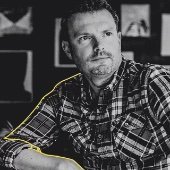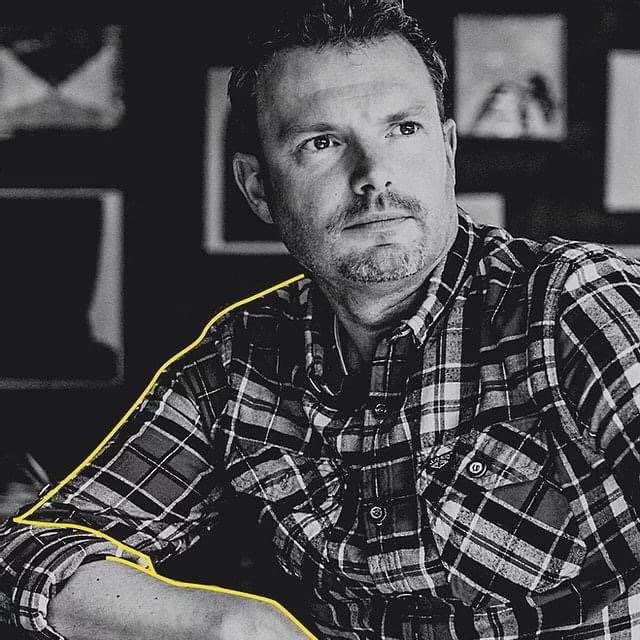-
Posts
4,709 -
Joined
-
Last visited
Content Type
Profiles
Forums
Events
Gallery
Everything posted by JeroenPeters
-
Hi Jim, I guess the easiest way is by Dry-brushing. Take a large old sof brush, put a little Testors (Model Master) Chrome on it and smear and wipe till practically nothing comes off. Really almost nothing. Spray a surface in the colour you want, let it dry and gently brush with the soft brush. I use Testors Chrome. I also like to spray a base of Alclad and the next day thinly spray the colour I want. But if you're starting out the first option works best. I love the Testors screw cap Chrome because it never really dries on your brush. instead it turns powdery which makes you use and re-use this brush without cleaning. Hope this helps. Cheers, Jeroen
-
No! Don't let me scare you off! This kit is actually quite easy. It fits very very well. There's just one small area to correct as you can see in my WIP. And that's the space between the ailerons and wing. This plane is cool and if you build it, I will help you where I can. Really happy you're drawn in! Cheers, Jeroen
-

Leopard 2A6M Early Version
JeroenPeters replied to Abramsguy21's topic in LSM 1/35 and Larger Work In Progress
That looks amazing... Very impressive. The PE must have been a nightmare! What did you use for pigments? Cheers, Jeroen -

Suggestions needed..........( model for 9 year old ) (??)
JeroenPeters replied to olfogey's topic in Modelling Discussion
Hi Jim, These are also pretty cool: http://www.entertainmentearth.com/prodinfo.asp?number=DRZVE2061#.Uo3mi5Ho480 -
Call of Duty IV opening scene! Yeah! Nice.
-

Hansa Brandenburg W.29
JeroenPeters replied to Umlaufmotor's topic in LSM 1/35 and Larger Work In Progress
That's a great technique! I have the same paints so I'm sure I should be able to do this -
Really 'cool' Paul! This would be a perfect testbase for Precision Ice and Snow. I'm working on the review right now. Great work.
-

Albatros Productions Windsock 'World War Centenary' Vol.29, No.5
JeroenPeters replied to James H's topic in Tools, Books & Misc.
Nice one! Great Ninak in there... -

Fokker E.IV, 163/16, AOK 3 Fokkerstaffel, Kurt Student, August 1916
JeroenPeters replied to James H's topic in Eindecker GB
Very nice. I'll get some of that Mig wash too. Using HGW wash now, but am keen on trying this. And those pastels are a nice touch too.- 28 replies
-
- 1
-

-

1/32 Rocket Science: Me 163 (Meng)
JeroenPeters replied to JeroenPeters's topic in LSM 1/35 and Larger Work In Progress
Well it's impossible to get a good photo form this, but here are the cannons. First layer: Alclad steel. Second layer: Gunze clear coat Third layer: AK chipping agent. Fourth layer: Satin black / grey and brown Fifth layer: black areas Then some chipping. Then a wash with oils and next up a little dry brushing. -

1/32 Rocket Science: Me 163 (Meng)
JeroenPeters replied to JeroenPeters's topic in LSM 1/35 and Larger Work In Progress
Preparing for the gun bays and figuring out where the wiring goes. At the back you can see the compressed air bottle that operates the cannon. Funny enough, in our own walk around it appears to be below the cannon. -

1/32 Rocket Science: Me 163 (Meng)
JeroenPeters replied to JeroenPeters's topic in LSM 1/35 and Larger Work In Progress
Thnx Sean, Here's where I'm at with the MK108 cannons. So.. I have MDC's nicely done versions, some leftover Trumpeter ones' and Meng's. And I've got Master metal barrels and blast tubes. Usually I don't think about it and replace as much as I can, but in this case I'll use the Meng cannons. There is hardly any difference in detail, so why bother? Actually... when you compare to the real thing (below) the Meng version is more accurate. The only thing missing are two slight bulges on the breach and two small holes. Easy fix. The size all match up. The gun bay area will only receive some wiring and cables. That's it. Reason the Meng version in the pic (top) is longer, is that it has the blast tube moulded on. -

R.A.F. FE2b Reproduction RAF Museum Hendon
JeroenPeters replied to One-Oh-Four's topic in Walkarounds
When everyone was tired after Telford and wanted to go home straight away, Erik said: no! We must go to Hendon on the way back to shoot a walk around for Jeroen Veen. Really happened.- 7 replies
-
- 1
-

-
- FE2b
- Night Bomber
-
(and 4 more)
Tagged with:
-
JG 2 Jagdgeschwader „Richthofen” Marek J. Murawski Kagero Books (Units 5 / 97005) Available from Kagero for €16,71 A lot has been written on one of the most famous Jagdgeschwaders: JG 2. Enough to fill a small library. And that’s exactly when I like to have a compact writing that sums up highlights and gives oversight. This small book does just that! It chronologically covers the units’ actions in 28 pages, flanked by 43 photo’s. Starting with the units pre-war history (May 1, 1934 - August 31, 1939) until the end of WW2 (June 6, 1944 - May 1945). The text is in english and reads very well. Like with their Topcolors series, Kagero includes very nice and large colour profiles of 4 JG 2 airframes. Left and right view. The aircraft covered are: • Messerschmitt Bf 109 E-4 W.Nr. 5159, 'White 9', flown by Oblt. Hermann Reifferscheidt, Kapitän of 1./JG 2, Beaumont-le-Roger airfield, France, October 1940 • Messerschmitt Bf 109 F-2/B 'Yellow 3', flown by Uffz. Richard Übelbacher of 6.(Jabo)/JG 2, Abbeville-Drucat airfield, France, summer 1941 • Focke-Wulf Fw 190 A-2 W.Nr. 0120 333, 'White 8', flown by Lt. Jakob Augustin of 7./JG 2, Théville airfield, France, early June 1942 • Focke-Wulf Fw 190 D-9 W.Nr. 400 271, 'Black 4' of 10./JG 2, Großostheim airfield, Germany, spring 1945 The decals themselves are printed the way we can expect from Cartograf. Perfect in register and true of color. They come in 1:72, 1:48 and off course… 1/32! Conclusion As said: with a unit so overly covered as JG 2, I find it comfortable to have a summary of highlights and timeline to freshen up on the subject when modeling on the subject. The photographs are large and clear, the text reads quick and comprehensible and the colour profiles are of the quality we have come to expect from Kagero. And not unimportant, the decals are printed by Cartograf. One of the best decal printers around. Very highly recommended Our sincere thanks to Kagero Publishing for the review sample. To purchase directly, click HERE. Jeroen Peters
-
Great review Jim. Very nice. Surface detail is up to par. I think this kit will be a nice base for many after market companies...
-

1/32 Rocket Science: Me 163 (Meng)
JeroenPeters replied to JeroenPeters's topic in LSM 1/35 and Larger Work In Progress
Thnx guys! I love this little kit. Here's a shot of the pit connected to the fuel drum and ammo bay. A nice and compact sub installation.. -
Wow amazing planes, weather and pics! Thnx for sharing!!
-

Hansa Brandenburg W.29
JeroenPeters replied to Umlaufmotor's topic in LSM 1/35 and Larger Work In Progress
Oh my god!! This is amazing! I love the wooden stock on the guns. This is just too good... Can't wait fro more... -

1/32 Rocket Science: Me 163 (Meng)
JeroenPeters replied to JeroenPeters's topic in LSM 1/35 and Larger Work In Progress
Wow! I can tell w'ere growing fast on the forum when I need to scroll and search for my own build! Here's some progress on the Mk108 ammo. Brownish metal casing, yellow grenade, green band and copper tip. -
Good idea. I think a kit of the year should have done something for the hobby by raising the bar or breaking down a wall that and leading the way for new things to come. The 1/24 Typhoon does that in respect of the stressed metal skin effect that i have not seen before on a model. But this model won't be released this year. The HK Models B17 is huge. A very bold statement in the hobby. It gets my respect. But if I had to choose I'd go for the Cat... Not that I'd ever build one, but the detail, engineering, getting resin in quality so close to Injection plastic... That is raising the bar in my book.
-
Ah ok. Might be. I once got the Voyager set for the Sturer Emil. I believe that included the barrel. Same as the set Ihave for the 1/100 U-boat. It includes metal barrels and turned metal torpedoes. Voyager makes the nicest upgrades but you need tiny hands and a big magnifying glass.
-
That Voyager set looks Amazing. Daunting. Scary. But amazing. Only thing I don't get is why they did not include a metal replacement barrel...

